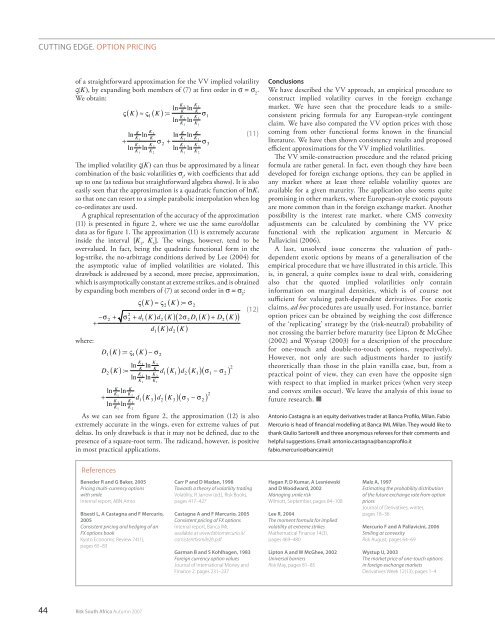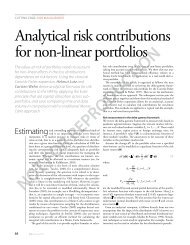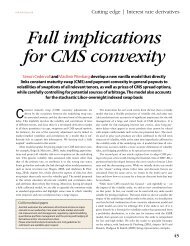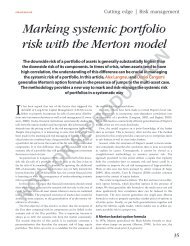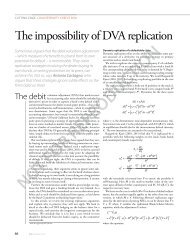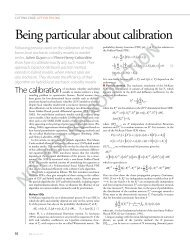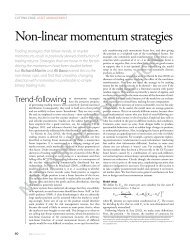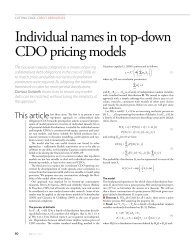The vanna-volga method for implied volatilities (PDF - Risk.net
The vanna-volga method for implied volatilities (PDF - Risk.net
The vanna-volga method for implied volatilities (PDF - Risk.net
Create successful ePaper yourself
Turn your PDF publications into a flip-book with our unique Google optimized e-Paper software.
cutting edge. option pricing<br />
of a straight<strong>for</strong>ward approximation <strong>for</strong> the VV <strong>implied</strong> volatility<br />
ς(K), by expanding both members of (7) at first order in s = s 2 .<br />
We obtain:<br />
ς( K ) ≈ ς1 K<br />
44 risk South Africa Autumn 2007<br />
+ ln K<br />
ln K1 K 3<br />
K<br />
ln K 2 ln K1 K 3<br />
K 2<br />
( ) := ln K 2<br />
σ 2 +<br />
K ln K 3<br />
K<br />
ln K 2 ln K1 K 3<br />
K1 K ln ln K1 K<br />
K 2<br />
ln K 3 ln K1 K 3<br />
K 2<br />
σ 1<br />
σ 3<br />
(11)<br />
<strong>The</strong> <strong>implied</strong> volatility ς(K) can thus be approximated by a linear<br />
combination of the basic <strong>volatilities</strong> s , with coefficients that add<br />
i<br />
up to one (as tedious but straight<strong>for</strong>ward algebra shows). It is also<br />
easily seen that the approximation is a quadratic function of lnK,<br />
so that one can resort to a simple parabolic interpolation when log<br />
co-ordinates are used.<br />
A graphical representation of the accuracy of the approximation<br />
(11) is presented in figure 2, where we use the same euro/dollar<br />
data as <strong>for</strong> figure 1. <strong>The</strong> approximation (11) is extremely accurate<br />
inside the interval [K , K ]. <strong>The</strong> wings, however, tend to be<br />
1 3<br />
overvalued. In fact, being the quadratic functional <strong>for</strong>m in the<br />
log-strike, the no-arbitrage conditions derived by Lee (2004) <strong>for</strong><br />
the asymptotic value of <strong>implied</strong> <strong>volatilities</strong> are violated. This<br />
drawback is addressed by a second, more precise, approximation,<br />
which is asymptotically constant at extreme strikes, and is obtained<br />
by expanding both members of (7) at second order in s = s : 2<br />
ς( K ) ≈ ς 2 ( K ) := σ 2<br />
where:<br />
+ −σ 2 + σ 2<br />
2 + d1 K<br />
D1 ( K ) := ς1 ( K ) − σ 2<br />
D 2 K<br />
+ ln K<br />
( ) := ln K 2<br />
ln K1 K<br />
K 2<br />
ln K 3 ln K1 K 3<br />
K 2<br />
( ) ( 2σ 2 D1 ( K ) + D2 ( K ) )<br />
( )<br />
( )d 2 K<br />
d1 ( K )d 2 K<br />
K ln K 3<br />
K<br />
ln K 2 ln K1 K 3<br />
K1 d1 ( K1 )d 2 ( K1 ) ( σ1 − σ 2 ) 2<br />
d1 ( K 3 )d 2 ( K 3 ) ( σ 3 − σ 2 ) 2<br />
(12)<br />
As we can see from figure 2, the approximation (12) is also<br />
extremely accurate in the wings, even <strong>for</strong> extreme values of put<br />
deltas. Its only drawback is that it may not be defined, due to the<br />
presence of a square-root term. <strong>The</strong> radicand, however, is positive<br />
in most practical applications.<br />
References<br />
Beneder R and G Baker, 2005<br />
Pricing multi-currency options<br />
with smile<br />
Internal report, ABN Amro<br />
Bisesti L, A Castagna and F Mercurio,<br />
2005<br />
Consistent pricing and hedging of an<br />
FX options book<br />
Kyoto Economic Review 74(1),<br />
pages 65–83<br />
Carr P and D Madan, 1998<br />
Towards a theory of volatility trading<br />
Volatility, R Jarrow (ed.), <strong>Risk</strong> Books,<br />
pages 417–427<br />
Castagna A and F Mercurio, 2005<br />
Consistent pricing of FX options<br />
Internal report, Banca IMI,<br />
available at www.fabiomercurio.it/<br />
consistentfxsmile2b.pdf<br />
Garman B and S Kohlhagen, 1983<br />
Foreign currency option values<br />
Journal of International Money and<br />
Finance 2, pages 231–237<br />
Conclusions<br />
We have described the VV approach, an empirical procedure to<br />
construct <strong>implied</strong> volatility curves in the <strong>for</strong>eign exchange<br />
market. We have seen that the procedure leads to a smileconsistent<br />
pricing <strong>for</strong>mula <strong>for</strong> any European-style contingent<br />
claim. We have also compared the VV option prices with those<br />
coming from other functional <strong>for</strong>ms known in the financial<br />
literature. We have then shown consistency results and proposed<br />
efficient approximations <strong>for</strong> the VV <strong>implied</strong> <strong>volatilities</strong>.<br />
<strong>The</strong> VV smile-construction procedure and the related pricing<br />
<strong>for</strong>mula are rather general. In fact, even though they have been<br />
developed <strong>for</strong> <strong>for</strong>eign exchange options, they can be applied in<br />
any market where at least three reliable volatility quotes are<br />
available <strong>for</strong> a given maturity. <strong>The</strong> application also seems quite<br />
promising in other markets, where European-style exotic payouts<br />
are more common than in the <strong>for</strong>eign exchange market. Another<br />
possibility is the interest rate market, where CMS convexity<br />
adjustments can be calculated by combining the VV price<br />
functional with the replication argument in Mercurio &<br />
Pallavicini (2006).<br />
A last, unsolved issue concerns the valuation of pathdependent<br />
exotic options by means of a generalisation of the<br />
empirical procedure that we have illustrated in this article. This<br />
is, in general, a quite complex issue to deal with, considering<br />
also that the quoted <strong>implied</strong> <strong>volatilities</strong> only contain<br />
in<strong>for</strong>mation on marginal densities, which is of course not<br />
sufficient <strong>for</strong> valuing path-dependent derivatives. For exotic<br />
claims, ad hoc procedures are usually used. For instance, barrier<br />
option prices can be obtained by weighing the cost difference<br />
of the ‘replicating’ strategy by the (risk-neutral) probability of<br />
not crossing the barrier be<strong>for</strong>e maturity (see Lipton & McGhee<br />
(2002) and Wystup (2003) <strong>for</strong> a description of the procedure<br />
<strong>for</strong> one-touch and double-no-touch options, respectively).<br />
However, not only are such adjustments harder to justify<br />
theoretically than those in the plain vanilla case, but, from a<br />
practical point of view, they can even have the opposite sign<br />
with respect to that <strong>implied</strong> in market prices (when very steep<br />
and convex smiles occur). We leave the analysis of this issue to<br />
future research. n<br />
Antonio castagna is an equity derivatives trader at Banca profilo, Milan. Fabio<br />
Mercurio is head of financial modelling at Banca iMi, Milan. they would like to<br />
thank giulio Sartorelli and three anonymous referees <strong>for</strong> their comments and<br />
helpful suggestions. email: antonio.castagna@bancaprofilo.it<br />
fabio.mercurio@bancaimi.it<br />
Hagan P, D Kumar, A Lesniewski<br />
and D Woodward, 2002<br />
Managing smile risk<br />
Wilmott, September, pages 84–108<br />
Lee R, 2004<br />
<strong>The</strong> moment <strong>for</strong>mula <strong>for</strong> <strong>implied</strong><br />
volatility at extreme strikes<br />
Mathematical Finance 14(3),<br />
pages 469–480<br />
Lipton A and W McGhee, 2002<br />
Universal barriers<br />
<strong>Risk</strong> May, pages 81–85<br />
Malz A, 1997<br />
Estimating the probability distribution<br />
of the future exchange rate from option<br />
prices<br />
Journal of Derivatives, winter,<br />
pages 18–36<br />
Mercurio F and A Pallavicini, 2006<br />
Smiling at convexity<br />
<strong>Risk</strong> August, pages 64–69<br />
Wystup U, 2003<br />
<strong>The</strong> market price of one-touch options<br />
in <strong>for</strong>eign exchange markets<br />
Derivatives Week 12(13), pages 1–4


